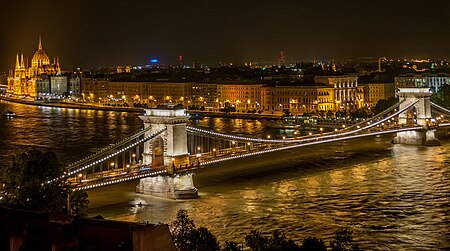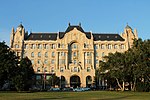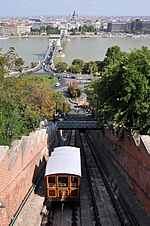Széchenyi Chain Bridge

The Széchenyi Chain Bridge (Hungarian: Széchenyi lánchíd [ˈseːt͡ʃeːɲi ˈlaːnt͡shiːd]) is a chain bridge that spans the River Danube between Buda and Pest, the western and eastern sides of Budapest, the capital of Hungary. Designed by English engineer William Tierney Clark and built by Scottish engineer Adam Clark, it was the first permanent bridge across the Danube in Hungary. It was opened in 1849. It is anchored on the Pest side of the river to Széchenyi (formerly Roosevelt) Square, adjacent to the Gresham Palace and the Hungarian Academy of Sciences, and on the Buda side to Adam Clark Square, near the Zero Kilometre Stone and the lower end of the Castle Hill Funicular, leading to Buda Castle. The bridge has the name of István Széchenyi, a major supporter of its construction, attached to it, but is most commonly known as the "Chain Bridge". At the time of its construction, it was regarded as one of the modern world's engineering wonders. Its decorations are made of cast iron.
Excerpt from the Wikipedia article Széchenyi Chain Bridge (License: CC BY-SA 3.0, Authors, Images).Széchenyi Chain Bridge
An der Weide, Samtgemeinde Ostheide
Geographical coordinates (GPS) Address Nearby Places Show on map
Geographical coordinates (GPS)
| Latitude | Longitude |
|---|---|
| N 47.498888888889 ° | E 19.043611111111 ° |
Address
An der Weide 8
21401 Samtgemeinde Ostheide
Niedersachsen, Deutschland
Open on Google Maps









